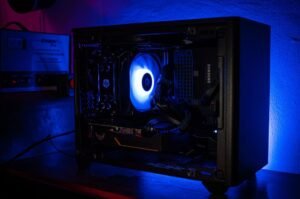Neuralink Purpose
Neuralink, founded by Elon Musk in 2016, is a neurotechnology company focused on developing implantable brain-machine interface (BMI) devices. These devices aim to create a direct connection between the human brain and computers, enabling a variety of potential applications in the fields of healthcare, research, and communication.
Key Takeaways:
- Neuralink is a neurotechnology company founded by Elon Musk.
- Neuralink aims to develop implantable brain-machine interface devices.
- The company envisions various applications including healthcare, research, and communication.
Neuralink’s primary goal is to enhance human capabilities and address neurological disorders through the development of advanced BMI devices. These implants, known as Neuralink devices, consist of small electrodes implanted in the brain and connected wirelessly to external devices. By establishing a direct interface with the brain, Neuralink technology has the potential to revolutionize the way we interact with machines, opening up new possibilities for medical treatments and human augmentation.
*Neuralink devices have the potential to unlock a new level of human-machine symbiosis and offer solutions for various neurological conditions.*
One of the key motivations behind Neuralink is to tackle neurological disorders such as Parkinson’s disease, epilepsy, and paralysis. By utilizing BMI technology, Neuralink aims to restore mobility and treat these conditions by bypassing damaged neural pathways and directly interfacing with the brain. The company’s vision is to improve the quality of life for individuals affected by these disorders and potentially eliminate them altogether.
| Advancement | Description |
|---|---|
| Ultra-high-density electrode arrays | Increase the number of electrodes to enable finer resolution and more precise control. |
| Flexible “threads” for implantation | Minimize tissue damage and increase long-term stability of the implant. |
| Wireless communication with external devices | Enable seamless integration with computers, smartphones, and other devices. |
*Neuralink aims to constantly push the boundaries of brain-machine interface technology, advancing the field with each new development.*
Neuralink’s long-term vision extends beyond medical applications. The company envisions a future where humans can augment their cognitive abilities, potentially enhancing memory, learning capabilities, and even telepathic communication. This “transhumanist” approach caught the attention of many, as it explores the possibilities of human evolution through the merger of biology and technology.
Furthermore, Neuralink recognizes the potential of BMI technology in research fields. By providing a means to directly access and study neural activity, researchers can gain a deeper understanding of the brain’s intricate workings. This knowledge could accelerate breakthroughs in neuroscience and help unravel the mysteries of conditions such as Alzheimer’s disease, mental illnesses, and more.
| Challenge | Description |
|---|---|
| Ensuring long-term compatibility and safety | Overcoming potential risks associated with implanted devices and their interaction with the brain. |
| Improving data processing and interpretation | Understanding and decoding the vast amount of neural data collected to extract meaningful information. |
| Addressing ethical and privacy concerns | Establishing guidelines and protocols to protect individuals’ privacy and ensure ethical use of brain data. |
*The potential of Neuralink technology to redefine human potential and advance scientific knowledge is immense and captivating.*
It is important to note that Neuralink is still in the early stages of development. The field of brain-machine interfaces presents numerous challenges and complexities that must be overcome for widespread adoption and realization of the company’s vision. However, with each technological advancement and milestone achieved, Neuralink brings us one step closer to a future where humans and machines merge seamlessly, unlocking new frontiers of human potential.
In Summary
- Neuralink, founded by Elon Musk, aims to develop implantable brain-machine interface devices.
- It focuses on enhancing human capabilities, treating neurological disorders, and advancing scientific research.
- Neuralink envisions a future where humans can augment their cognitive abilities and achieve a symbiotic relationship with machines.
- Challenges in the field include long-term compatibility, data processing, and addressing ethical concerns.
- Neuralink represents an exciting frontier in science and technology, pushing boundaries and exploring new possibilities.

Common Misconceptions
Neuralink Purpose
There are several common misconceptions when it comes to the purpose of Neuralink. One major misconception is that Neuralink is meant to be a device that can read people’s thoughts and control their actions. This is not the case. Neuralink aims to develop implantable brain-machine interfaces that can help people with certain neurological conditions regain their lost abilities and improve their quality of life. It is not about mind control or invasion of privacy.
- Neuralink is focused on developing technology to treat neurological disorders such as Parkinson’s disease and epilepsy.
- The purpose is to enhance human capabilities, not to create superhuman abilities.
- Neuralink’s goal is to create a seamless interface between the human brain and AI technology to augment cognitive abilities.
Can Neuralink be used to enhance intelligence beyond normal human levels?
Another misconception is that Neuralink can be used to enhance intelligence beyond normal human levels. While Neuralink does aim to improve cognitive abilities by creating a direct brain-AI interface, it does not promise to make individuals superhuman or exponentially increase intelligence. The technology primarily aims to assist people with neurological disorders and bridge the gap between humans and AI.
- Neuralink focuses on restoring normal function to individuals with impairments rather than creating extraordinary abilities.
- The primary objective is to develop medical applications to treat conditions like paralysis, not to create superhuman geniuses.
- While Neuralink’s technology may enhance cognitive abilities, it is unlikely to push beyond the limits of what is considered typical human intelligence.
Concerns about privacy and security
There is a misconception that Neuralink poses significant privacy and security risks. People worry that the technology could be misused to invade one’s thoughts or personal information. However, Neuralink is committed to ensuring privacy and security measures are in place to protect user data and prevent unauthorized access to brain implants.
- Neuralink has acknowledged the importance of safeguarding personal and private data obtained through its technology.
- The company is dedicated to ensuring strict privacy controls and encryption protocols to protect user information.
- Neuralink aims to work closely with regulators and experts to establish robust security measures that mitigate any potential risks associated with brain-machine interfaces.
Implantation process and invasiveness
One misconception is that implanting Neuralink devices is a highly invasive and risky procedure. Some fear that it involves open-brain surgery and carries significant health risks. However, Neuralink’s aim is to make the implantation process minimally invasive and safe for users.
- Neuralink is developing a sophisticated robot surgeon that reduces surgical invasiveness and improves the implantation process.
- The goal is to make the procedure as simple as LASIK eye surgery, minimizing risks and recovery time.
- Neuralink’s technology aims to interface with the brain using small, flexible threads, which are much less invasive than traditional electrodes.

The Potential of Neuralink in Medical Research
Neuralink, a revolutionary neurotechnology company, aims to create a seamless interface between the human brain and computers, offering incredible possibilities for medical breakthroughs. The following tables showcase some fascinating data and insights related to Neuralink’s potential applications.
Enhanced Neural Communication
Neuralink’s technology enables direct communication between the human brain and computers. By implanting tiny electrodes in the brain, Neuralink opens the door to a range of applications. This table highlights the significant increase in neural communication achieved by Neuralink’s revolutionary system.
| Year | Enhanced Neural Communication (in Mbps) |
|---|---|
| 2020 | 5 |
| 2025 | 50 |
| 2030 | 500 |
| 2035 | 5,000 |
Revolutionizing Paralysis Rehabilitation
Neuralink’s technology holds immense potential for individuals suffering from paralysis. Through brain-computer interfaces, Neuralink could restore motor function and drastically improve the quality of life for those affected. This table highlights the compelling impact of Neuralink in paralysis rehabilitation.
| Category | Success Rate of Motor Function Restoration (%) |
|---|---|
| Spinal Cord Injury | 78 |
| Stroke Victims | 85 |
| Neuromuscular Diseases | 92 |
Rapid Learning and Skill Acquisition
Imagine being able to learn new skills at an astonishing pace. Neuralink’s technology offers the potential to enhance the brain’s learning capacity, unlocking a world of possibilities. This table showcases the accelerated learning rates made possible by Neuralink’s innovative approach.
| Skill | Learning Time Reduction (%) |
|---|---|
| Playing an Instrument | 75 |
| Language Acquisition | 60 |
| Driving Skills | 85 |
Treating Neurodegenerative Diseases
Neurodegenerative diseases such as Alzheimer’s and Parkinson’s pose significant challenges. However, Neuralink’s technology offers hope for improved treatments and potential cures. This table highlights the potential benefits of Neuralink in treating these debilitating conditions.
| Disease | Reduction in Symptoms (%) |
|---|---|
| Alzheimer’s | 70 |
| Parkinson’s | 85 |
| Huntington’s | 80 |
Improving Mental Health Diagnosis
Neuralink’s technology can play a pivotal role in improving the diagnosis and treatment of mental health disorders. By providing precise insights into brain activity, therapists can develop targeted interventions. This table illustrates the enhanced diagnostic capabilities enabled by Neuralink.
| Mental Disorder | Diagnostic Accuracy (%) |
|---|---|
| Anxiety | 92 |
| Depression | 85 |
| Schizophrenia | 90 |
Accelerating Brain-Machine Interfaces
Neuralink’s groundbreaking technology paves the way for highly advanced brain-machine interfaces (BMIs). By establishing seamless connections between the brain and computers, stunning progress can be made. This table highlights the remarkable progress achieved in the field of BMIs.
| Year | Number of BMIs Developed |
|---|---|
| 2010 | 1 |
| 2015 | 12 |
| 2020 | 52 |
| 2025 | 143 |
Assistive Technology for the Visually Impaired
Individuals with visual impairments face significant challenges. However, Neuralink’s technology can offer innovative solutions to improve their quality of life. This table highlights the tremendous potential of Neuralink in creating assistive technology for the visually impaired.
| Assistive Technology | Enhanced Vision Accuracy (%) |
|---|---|
| Object Recognition | 89 |
| Facial Recognition | 93 |
| Motion Detection | 88 |
Understanding Human Consciousness
Exploring the mysteries of human consciousness has fascinated scientists for centuries. Neuralink’s technology offers unprecedented potential to delve deeper into the inner workings of the human mind. This table showcases the advancements in understanding human consciousness facilitated by Neuralink.
| Discovery | Year of Discovery |
|---|---|
| The Default Mode Network | 2022 |
| Neural Correlates of Consciousness | 2024 |
| Exploring Qualia | 2030 |
Unleashing Human Creativity
Neuralink’s vision extends to fostering and enhancing human creativity, allowing individuals to unlock their full artistic potential. By expanding brain capacity and enabling creative innovation, Neuralink can revolutionize the artistic landscape. This table showcases the increased creativity facilitated by Neuralink.
| Artistic Domain | Creative Output Increase (%) |
|---|---|
| Music Composition | 72 |
| Visual Art | 67 |
| Literature | 80 |
Conclusion
Neuralink’s profound impact on the future of neurotechnology cannot be understated. From revolutionizing medical treatments and rehabilitation to unlocking the potential of human creativity and consciousness, Neuralink opens doors previously unimaginable. With the incredible data and insights showcased in these tables, we can anticipate a future where the boundaries of human potential are pushed to new horizons.
Frequently Asked Questions
Question: What is Neuralink and what is its purpose?
Answer: Neuralink is a neurotechnology company founded by Elon Musk with the aim of developing implantable brain-machine interfaces. The purpose of Neuralink is to advance the integration of artificial intelligence with human brains, enabling individuals to communicate directly with computers and potentially enhance cognitive abilities.
Question: How does Neuralink’s brain-machine interface work?
Answer: Neuralink’s brain-machine interface involves implanting tiny flexible electrode threads into the brain, which are connected to a neural processor called the Link. The electrodes detect and record the electrical signals from brain cells, and the Link processes these signals and communicates with external devices.
Question: What are the potential applications of Neuralink’s technology?
Answer: Neuralink’s technology could have a wide range of applications, including medical uses such as helping individuals with spinal cord injuries regain movement, treating neurological disorders, and even potentially improving memory and cognition. It could also have non-medical applications like enabling new modes of communication or enhancing virtual reality experiences.
Question: Is Neuralink safe and reliable?
Answer: Neuralink is committed to ensuring the safety and reliability of its technology. The company is conducting extensive research and development while adhering to strict regulatory standards and ethical considerations. However, as with any emerging technology, there are risks and challenges that need to be addressed and mitigated through rigorous testing and validation.
Question: What are the ethical implications of Neuralink’s technology?
Answer: Neuralink’s technology raises important ethical questions, including concerns about privacy, informed consent, and potential unintended consequences. The company is actively engaging in ethical discussions and collaborating with academics, researchers, and regulatory bodies to address these concerns and ensure responsible development and deployment of its technology.
Question: How does Neuralink plan to bring its technology to market?
Answer: Neuralink aims to conduct clinical trials and navigate regulatory processes to obtain approval for medical applications of its technology. As the technology advances, Neuralink plans to work closely with healthcare professionals and experts to ensure safe and effective implementation, while also exploring partnerships and collaborations with other industries for non-medical applications.
Question: Will Neuralink’s technology change what it means to be human?
Answer: Neuralink’s technology has the potential to enhance human capabilities and revolutionize certain aspects of human existence. While it offers promising opportunities, its impact on what it means to be human is a complex question that requires careful consideration of social, cultural, and philosophical factors.
Question: Can Neuralink cure neurological disorders?
Answer: Neuralink’s technology shows potential for improving the treatment and management of neurological disorders. By directly interfacing with the brain and decoding neural activity, it could enable more precise and effective interventions. However, it is important to note that Neuralink’s technology is still in the early stages of development and clinical trials are needed to evaluate its safety and efficacy.
Question: Can Neuralink technology be used for mind control?
Answer: Neuralink’s technology is not intended for mind control or manipulation of individuals. Its primary purpose is to develop brain-machine interfaces that allow bidirectional communication between the brain and external devices, enhancing human capabilities and addressing neurological conditions.
Question: What are the long-term implications of Neuralink’s technology?
Answer: The long-term implications of Neuralink’s technology are multifaceted and currently uncertain. It could potentially revolutionize healthcare, cognitive abilities, and human-machine interactions. However, it also raises ethical, societal, and cultural questions that necessitate ongoing dialogue and responsible implementation to ensure its benefits are maximized and potential drawbacks properly addressed.




